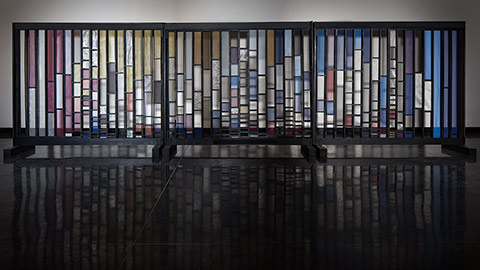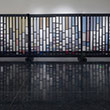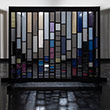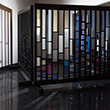Tracing Genetic Inheritance: Recent Work By Geraldine Ondrizek
October 5 - December 7, 2016
Reception for the Artist Tuesday October 18, 4–6pm
Artist lecture Wednesday October 19, 11:30am - 1pm, Lecture Hall 1
Geraldine Ondrizek has been creating multi-layered, thought-provoking works of art for more than 25 years. She is a deep researcher and collaborator across disciplines, drawing on art, science, history, anthropology, psychology, biology, and so much more. Through her art she addresses issues of identity, relationships, memory, and inheritance, on a personal level and on a global scale. Many of her large-scale installations, including the three exhibited here, explore the pursuit of knowledge about genetics, and how this information can lead us toward life-saving discoveries, deeper understanding of the human race, and moral ambiguities.
For each concept that she explores artistically, Ondrizek finds the physical means that best convey her ideas, using both soft materials and hard, time-honored techniques and state-of-the-art. Fabrics have strong tactile, emotional, and socio-political connotations woven since early in the history of the human race, used by all of us every day. Often considered lower in the artistic hierarchy of Western cultures - “women’s work” - fiber arts were embraced by early feminists and have since been “elevated” in the hierarchy. Steel and wood, the structural elements of our buildings, shelter, and tools, are not only the armatures of her installations, Ondrizek finely works each element to evoke place, pattern, memory, familiarity, and distance.
Tracing Genetic Inheritance brings together three recent installations by Ondrizek. For the earliest, Chromosome Painting Edition II 1-X, Ondrizek transforms scientific renderings often seen in a textbook into 10-foot-tall silk panels, lush and luminous, visually enticing us to learn more. Shades of White invites us into a maze of hanging boxes hung near head-height, so we look in and through, seeing ourselves and others veiled by silk dyed in subtle skin tones. The falseness of categorizing by color, alluded to here, is more concretely and ominously spelled out in the artist’s statement, where Ondrizek talks about the history of eugenics. For mtDNA, Ondrizek is inspired by color charts that trace matrilineal descent of peoples, and instead of the hard steel of Shades of White, she uses hand-worked wood supports, referencing screened porches where women could sit and see out but not be seen by people on the other side of the screen. It’s as if the women can see their own contributions to the flow of cultures, but others might not.
Ondrizek is a consummate artist, with a great depth of understanding and expressive passion. She brings this to all her artworks, and this summer she brought this expertise to Evergreen to install these artworks. Her commitment to this project has been intense and unflagging, and we thank her for this as well as her extraordinary creativity. We also want to thank several at Evergreen who worked with her during her days here, helping to put together these ambitious installations: student Michael Sciano and staff Patrick Rau and Don Jensen. Ann Friedman, Curator and Director, The Evergreen Gallery
Works in the exhibition
mtDNA, 2016
Rough milled and handcrafted cedar screen, black paint, 100% silk from Uzbekistan and China, natural dyes
4’H x 24” W x 20’L
The Installation mtDNA is based on a graph representing the 1000 Genomes Project tracing mitochondrial DNA worldwide. The research, which is ongoing, shows how varied and diverse the matrilineal DNA is for each person in each haplogroup (genetic population group), within each country. As indicated in the chart, individual ancestry proportions varied substantially in all but a few of the major mtDNA haplogroups. The research is significant because it provides an overview of all human genetic variation, not only what is already known to be biomedically relevant. The consortium will generate a valuable tool for all fields of biological science, especially in the disciplines of genetics, medicine, pharmacology, biochemistry, and bioinformatics.
The work will inform viewers on multi-racial groups as well as inhabit a physical space and allow the viewers to see though the semi-translucent silk to the others in the space. The screen structure is based on a mashrabiya, an element in traditional Arabic and North African Architecture which is a carved wood latticework located on the second story of a building and often lined with stained glass. The mashrabiya is a cool shaded space primarily used by women as a place to see out but not be seen. It is both protective and a space of observation. Significantly, in tracing mtDNA globally, we find that the human origins of the mtDNA or our “EVE” was from Africa.
My interest in interpreting the current on the genetic spectrum passed down from our mothers. Each line in the graph represents a haplogroup, group of people in a geographic region. The blue tones are Asia, reds and pinks are Africa, orange the Middle East, purple SE Asia through Persia, gold/yellow Russia, and Europe, I left open areas of the native populations.
CHROMOSOME PAINTING Edition II 1-X
Jacquard dye and dye sublimation, printed on Ultra Sheer® and sheer silk
Panels, 12 x 112”
The selection for this show:
CHROMOSOME 1. Prostate Cancer 2. Ovarian Cancer 3. Colon Cancer 4. Leukemia 5. Gastric Cancer 6. Ovarian Cancer 7. Colon Cancer 8. Hepatocellular Cancer 11. Bladder Cancer 12. Oral Cancer 13. Pancreatic Cancer 14. Lymphoma 15. Hodgkin’s Lymphoma 17. Breast Cancer
19. Leukemia T-cell Acute 20. Colon Cancer 21. Breast Cancer 22. Leukemia X. Testicular Cancer
SHADES OF WHITE
32 Boxes: Mild steel, 18-gauge, bent, welded, buffed, and coated with matte finish
Silk Panels: 100% silk from Uzbekistan and China, natural dyes.




